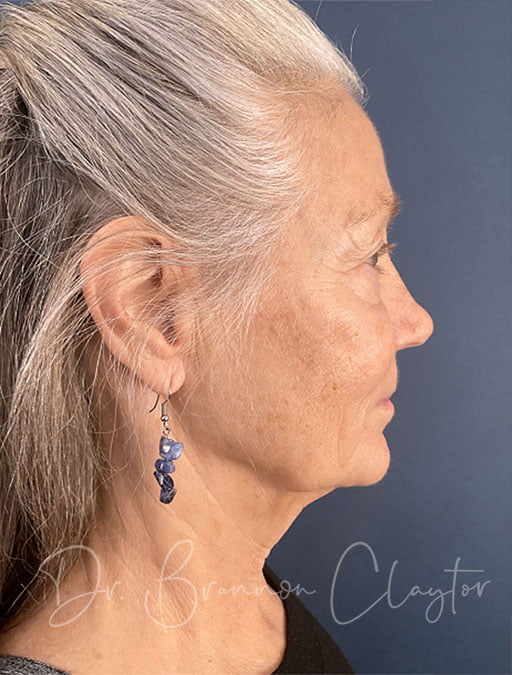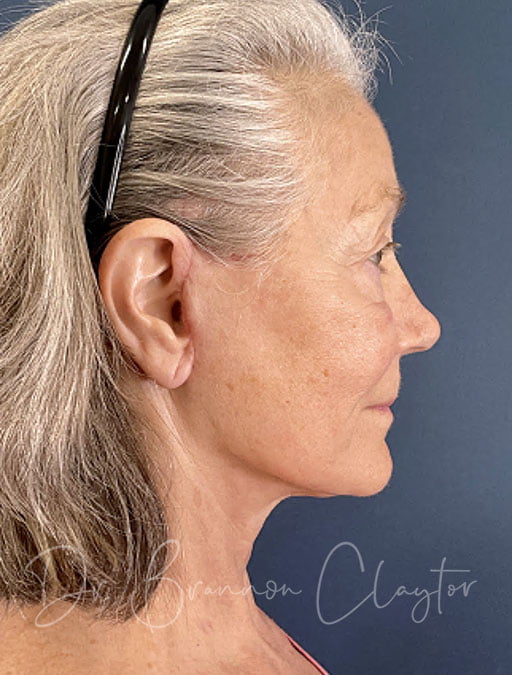Deep Plane Facelift (Rhytidectomy & Platysmaplasty)
What is a deep plane facelift?
Unlike traditional facelifts that are performed using the SMAS (superficial muscular aponeurotic system) method, deep plane facelifts allow your surgeon to treat the skin as well as underlying muscles and tissue. Shaping deeper facial tissues as part of your facelift can help you avoid the windswept look that can occur if sagging surface skin alone is overly tightened.
The deep plane facelift technique relies on small incisions within the hairline (along the sideburns), which allow access to the deeper facial ligaments tethering the SMAS to the underlying tissue. This requires extensive knowledge of facial nerves, which are quite delicate and run very close to the retaining ligaments; thus Dr. Claytor will immediately identify the patient’s facial nerve pathways and maintain their integrity throughout the process.
Continuing the deep plane facelift process, Dr. Claytor will manipulate the SMAS and skin as a unit, lifting, tightening, and anchoring the temporal fascia (deep connective tissues) higher up on the mid-face. Once facial tissues are in a lifted position, excess skin may be excised to create a more defined jawline and profile. Excess fat removal is also a part of a deep plane facelift, and in many cases, fat pads can be redistributed to achieve a youthful, volumized appearance. As tension is not placed singularly on the skin, with a deep plane facelift Dr. Claytor is able to create exceptionally natural-looking, long-lasting facial rejuvenation results.
This patient shares how her natural-looking results have impacted her life so far.I was given Dr Claytor’s name by my dermatologist, who didn’t know him but had seen his work on the faces of some of her patients and was impressed by the natural looking results. She was right, no one who didn’t know I had the procedure could tell, and I was out in public just one week afterwards. Everyone says, you look really good, did you lose weight, or change your hair?…Every friend who now knows has asked me to text them his info…
—Deep plane lower facelift patient, June 2022
Listen to more facelift patent stories »
Where are deep plane facelift scars placed?
Similar to a SMAS facelift, deep plane facelift incisions are strategically placed along the front and back curvatures of the ears. An additional incision is placed in the sideburn hairline. This allows scarring to be very inconspicuous—especially with Dr. Claytor’s meticulous surgical precision and proper scar care after surgery.
Video transcript
Dr. Claytor here sharing with you what is a deep plane facelift, and how does it generate that kind of improvement? So here we have our lovely patient her before and her after. And so her biggest frustration is her neck and her jowls that have come down. What she’s looking for is a more youthful return to her previous self, and that’s really what we’re after. We’re not about changing people and making them look different. We want them to be the best version of themselves.
What happens when we age is we get facial descent our malar eminence. Our bone here, it involutes and everything drops down. What we start to see is downward descent of our face and that is exhibited not only in jowling down here, but also in excess neck and fat skin down here. It’s very very frustrating and patients come in frequently saying, “Listen this is not who I am. I look in the mirror and I don’t see myself.” And actually, in the flex view, it’s even worse. So the goal of this operation is to rejuvenate the patient’s aging elements, to go into the face and lift back vertically what had been falling down inferiorly. The way we do this is with very small little incisions that are hidden along the ear, what we call the hairline and the sideburn region. And then these come back and they’re hidden back behind the ear and then they come down along the hairline there so that they’re very well disguised. Not infrequently I will also go up into here which gives me access to be lifting in that orientation with this SMAS that is going to be lifted.
That takes us to what is the difference between a SMAS plication and a deep plane facelift. That question comes up every single time a patient comes in for a consultation. And so it’s a great question and so we’re going to answer it here. So here we have our platysma muscle in our neck it really has no function other than being a muscle of animation. You move it around and you can see your neck muscles move. It has nothing to do with actually moving your head. Right along here is our mandible and the mandible comes down along here. And so below the mandible is where you have your platysma muscle. Above the mandible is where you have your SMAS muscle which stands for sub-muscular aponeurotic system. So you go from skin to SMAS down to the muscle and then you go down deeper to the bone. So when people have a SMAS plication what’s happening is the SMAS aspect of it is lifted and plicated up here and it’s for a very very superficial lift that goes on generally about as such. And so you’re really only getting about that much lift. Some people will go down here with it and allow the whole area to lift up but that’s what a SMAS plication is. In the deep plane lift what we’re doing is we are going underneath that SMAS so this SMAS is continuing up here and so you’re making the incisions that we’ve marked here and we’re lifting up that tissue and we’re moving in underneath the skin layer and then we’re coming up to this SMAS.
What we do in the deep plane lift so this is the deep plane is that we make the incision pretty much from the lateral aspect of the eye down to the corner of the jaw sort of in this orientation. That’s where we make the incision down into this SMAS to go up underneath it so that’s what’s the deep plane aspect of it. And while we’re there we come across these retaining ligaments. These are very very stout ligaments that sit here and here and here, and they’re what keep the face soft tissue from being advanced superiorly. They’re sort of, if you will, giant stakes in the ground that are preventing anything from moving around. And so we need to go in and first in the deep plane dissection dissect into the spaces in between these retaining ligaments. So we dissect down into here, we dissect down into here, and we dissect down into here so those tongues, if you will, are opened up. And then we can very clearly see around what’s going on, and we come across the retaining ligaments as we try to connect these two. What makes this operation so challenging are the facial nerves that are traveling in this area. They are very delicate, they’re very small, and they need to be treated with tremendous caution. Interestingly the nerves run very close to the retaining ligaments, so as you’re releasing the retaining ligaments you need to be looking for the very delicate facial nerves. The facial nerves come out from underneath the ear into a pattern that’s somewhat like this. So you can see that the deep plane facelift basically goes right along where the facial nerves are moving from behind the ear out into innervating the facial musculature and again this is what makes this operation so incredibly technically challenging. But if you can understand these different tongues that are advanced into the tongues that are advanced in between the retaining ligaments and then, therefore, allow connection between these two to further release and identify and remove these retaining ligaments to release them. Once these retaining ligaments are released now this entire area is very mobile and can be repositioned, and so if you look at people on a three-quarter view (this is that three-quarter view), patients who have a very high cheek area have a very youthful and aesthetic appearance when we age that cheek area drops down. That three-quarter view you see that area drop down and then it bunches up down here in the jowls which is really what gives you that aged appearance so by mobilizing this SMAS after you’ve released the retaining ligaments now with sutures. Remember I said that this area gets lifted so imagine that this entire area is now lifted up this way now sutures can be attached once these areas are connected and the retaining ligaments have been released and you very delicately worked around the facial nerves and left them intact now the sutures can be secured here and up here and that’s what takes this tissue and elevates it superiorly. That’s what creates the tremendous power and effect of the deep plane facelift.
If we move over to our after patient why does she look different? She looks different because all of these tissues have been moved up and we’ve been able to reposition her malar eminence back in a more youthful position. That’s part of it. The other part of it is down in the neck. How do we create this beautiful jawline? Well the way you do that is by coming down along the mandible here and releasing that platysma muscle, again, needing to be very careful of the facial nerves, but these are similarly just like these tongues into and underneath this SMA. This is released along here generally almost to about the corner of the mouth or what we call the marionette line. And so the release of the platysma is all the way along to there and by releasing that now you’re able to take this platysma muscle, which is part of the hanging sagging skin of the neck, and lift it and reorient it. In addition all the fat that’s in here is removed. All that excess fat we take out now once that’s released the muscle is then elevated and secured back here back into the mastoid fascia and that’s what creates that incredibly powerful strong neckline and jawline. There’s the mandible. Now that muscle which used to go this way, now the muscle comes up here and it’s very nicely secured back to the mastoid fascia here. With the platysma muscle section underneath the jawline that creates this gorgeous sharp neckline an incredibly well-defined jawline in combination with the SMAS now being elevated up superiorly and secured in this orientation. It gives you five 10-year lifting result of rejuvenating and refreshing and giving you that youthful appearance. The big difference again between the SMAS plication and the deep plane face lift is in this SMAS plication. You’re really just reefing up a small portion and you’re not releasing the retaining ligaments as opposed to the deep plane face lift where you’re going in underneath the SMAS, you’re identifying the facial nerves, you’re identifying the retaining ligaments, and you’re releasing the retaining ligaments. I can’t stress enough really the biggest difference between this SMAS placation and the deep plane facelift is the ability to release those deep retaining ligaments. That’s what gives you that very sustainable and dramatic lift, and addresses the jowl, and addresses the cheek region, and gives you that youthful shape back to your face.
I hope you found this helpful. Looking forward to making more of these videos to help explain some of these complex issues that are becoming more commonplace when patients come in and they’re bringing up topics. The patients are coming in today much more educated, and it’s so fun to be able to share this information in a digestible form so that when you come in you’ve got a framework to ask the questions as you’re looking for your rejuvenation journey. Thanks so much.
Are deep plane facelifts performed under local anesthesia?
Dr. Claytor offers IV sedation (general anesthesia) but this procedure can be safely and comfortably performed under local anesthesia. Patients experience “conscious sedation,” meaning they are technically awake but are completely relaxed and remain comfortable during surgery, avoiding the “hangover” that is experienced with IV sedation. Deep plane facelifts are performed in our Quad A-accredited surgery center, which has hospital-grade safety features while offering the convenience and luxury of a private facility.


This 71-year-old desired facial rejuvenation. After photos show 6 weeks post-op deep plane facelift performed under tumescent anesthesia.
*Individual results may vary.
Deep plane facelift = vertical facelift
You may have heard of the trending “vertical” face and neck lift, but did you know that this is the same as Dr. Claytor’s deep plane facelift? Deep plane facelifts release the retaining ligaments to vertically lift the SMAS and skin as one, creating a more natural, longer-lasting facelift. And, they may be combined with other procedures for comprehensive results.
Learn more: How Dr. Claytor performs a vertical facelift »
What is recovery like after a deep plane facelift?
Dr. Claytor’s meticulous surgical skill dramatically reduces postoperative swelling, bruising, and pain. Because the SMAS and skin are intact during this procedure, less trauma is experienced, helping you to enjoy a shorter recovery period. Once the surgery is complete, your face will be carefully wrapped in surgical gauze and compression wraps. A follow-up appointment will be scheduled for the next morning so Dr. Clayor can evaluate your first 12 hours of recovery. In the unlikely event a patient has fluid collection underneath the surgical site, a simple aspiration can address it. (Because surgical drains have the potential to cause complications and discomfort, Dr. Claytor has developed highly-regarded surgical techniques to avoid using drains in facelift recovery for the last decade.)
During your follow-up appointment, your dressings will be changed and Dr. Claytor will provide wound care instructions to you and your accompanying caregiver. Continuous wear of dressings and compression wraps will minimize bruising after surgery. After one week, patients will return for a follow-up visit so Dr. Claytor can monitor the healing process and remove your sutures. A final follow up appointment takes place between four to eight weeks; Dr. Claytor also enjoys seeing patients in the months following, when final results are achieved.
How long does a deep plane facelift last?
If expertly performed, a deep plane facelift can set the clock back on your appearance by 10+ years with results lasting 10-15 years. Deep plane facelift results last longer than those of a SMAS facelift because the underlying musculature is also treated, not just the SMAS and superficial skin.
Routine facial injectables, IPL skin revitalization, RF microneedling, CO2 laser, or laser skin tightening treatments will complement deep plane facelift results. Some patients may desire a touch-up surgical procedure to further extend the longevity of their deep plane facelift as they continue to age over time.
- Key Benefits
- Glossary
Lifts sagging facial tissues on a deeper plane: The deep plane facelift effectively lifts and repositions the deep structural layers of facial tissues, including ligaments. This technique keeps superficial skin and muscles intact and allows for a more comprehensive rejuvenation of the face, addressing deep-seated sagging and laxity.
Natural-looking outcome: By repositioning the underlying facial structures, a deep plane facelift can restore youthful contours without creating an overly tightened, windswept look.
Long-lasting: The deep plane facelift is known for providing highly durable results that are longer-lasting than those of a traditional facelift. By repositioning the supporting ligament of your underlying musculature, a deep plane lift helps to maintain the improvements achieved during the surgery for as long as 10-15 years.
Comprehensive results: Dr. Claytor most often performs the deep plane facelift (which primarily affects the midface and jowls) with an open platysmaplasty, which is an advanced neck lift method. This procedure plan can impact the face, cheeks, jawline, and neck to create a harmonious (and more natural looking) appearance.
SMAS (Superficial Musculoaponeurotic System): The SMAS is a layer of muscles and connective tissue that lies beneath the facial skin. The SMAS is often tightened during a deep plane facelift to provide a lifted appearance.
Consultation: A consultation is a scheduled meeting between a patient and a plastic surgeon where they discuss the patient’s cosmetic goals, medical history, and possible surgical options.
Rhytidectomy: Rhytidectomy, also known as a facelift, is a surgical procedure designed to reduce or eliminate visible signs of aging in the face and neck by tightening skin and underlying tissues.
General Anesthesia: A medically induced state of unconsciousness and lack of sensation used during surgeries to prevent pain and discomfort.
Nasolabial Folds: Nasolabial folds are the deep wrinkles or lines that extend from the sides of the nose down to the corners of the mouth, which often become more pronounced with age.
Excess Skin: The extra, sagging skin that often results from aging, significant weight loss, or other factors, sometimes necessitating surgical removal to improve appearances.
Lip Lift: A lip lift is a surgical procedure designed to shorten the space between the upper lip and the base of the nose, thereby enhancing the prominence and shape of the lips.
Connective Tissue: Biological tissue that provides support, binds together, and protects the various tissues and organs of the body, including skin and muscles.
Twilight Anesthesia: A sedation technique where patients are put into a drowsy, relaxed state but not entirely unconscious, often used for minor or shorter surgical procedures performed in the office setting.
Platysmaplasty: Surgical procedure or technique that tightens and repairs the platysma muscle in the neck, often performed to reduce sagging and create a more youthful jawline and neck.
Blepharoplasty (Eye Lift or Eyelid Lift): Blepharoplasty is a surgical procedure that corrects drooping or puffiness in the upper and/or lower eyes to improve the overall appearance of the eyes and face.
Fat Transfer or Fat Grafting: This procedure involves harvesting fat from one area of the patient’s body and injecting it into another area to restore volume or improve contours.
Rhinoplasty: Rhinoplasty, often referred to as a nose job, is a surgical procedure designed to reshape or resize the nose for aesthetic or functional purposes.
Platysma: A thin sheet-like muscle located in the neck, often tightened during a facelift to reduce the appearance of sagging or bands in the neck.
Composite Facelift: A comprehensive facelift procedure that not only addresses the SMAS but also lifts and repositions the skin and muscles of the mid-face, lower eyelids, and neck.
Minimally Invasive Facelift: A facelift technique that requires smaller incisions and less tissue manipulation, resulting in quicker recovery but offering more subtle results compared to a deep plane facelift.
Ptosis: A medical term describing the drooping or falling of a body part, often referring to sagging facial features that a facelift aims to correct.
Rhytidectomy: The technical term for a facelift, a surgical procedure that improves visible signs of aging in the face and neck.
Jowls: The sagging or droopy skin along the jawline or neck, often targeted and improved through facelift procedures.
Edema: Medical term for swelling, a common temporary side effect following surgical procedures.
Seroma: Accumulation of clear bodily fluids at the surgical site, which may need to be drained.
Hematoma: A collection of blood outside of blood vessels that may occur at the surgical site, sometimes requiring intervention.
Drainage: The removal of excess fluids, often through tubes, from the body post-operatively to aid in the healing process.
Facial Analysis: A systematic evaluation process used by surgeons to assess a patient’s facial anatomy, skin quality, and aging signs to recommend appropriate surgical or non-surgical interventions.
Candidacy: Evaluation of a patient’s overall health, medical history, and specific facial aging characteristics to determine their suitability for a deep plane facelift.
Collagen: A protein found in the skin and connective tissues, essential for maintaining skin strength and elasticity.
Elastin: A protein that allows the skin to resume its shape after stretching or contracting, helping it remain firm and tight.
Facial Fat Pads: Pockets of fat located in the face that provide volume and contour; these may shift or diminish with age, affecting the face’s overall appearance.
Neck Lift (platysmaplasty): A surgical procedure designed to improve visible signs of aging in the neck and jawline, often combined with facelifts for a more harmonious rejuvenation.
Contraindication: Conditions or factors that suggest a particular treatment or procedure may be harmful, thus should be avoided. For facelifts, contraindications may include certain medical conditions, lifestyle habits, or medications.
Listen to Stories From Dr. Claytor’s Deep Plane Facelift Patients
In the following audio stories, Dr. Brannon Claytor engages in conversations with his deep plane facelift patients, providing an authentic exploration of their experiences. From their encounters with anesthesia to the exceptional results, these stories offer insights into what it truly feels like to navigate recovery and results of a deep plane facelift procedure.
Good candidates for deep plane facelifts
Candidates for a deep plane facelift include patients in good health who are experiencing any of the following effects of aging:
- Jowls, droopy cheeks, or loose skin and fat under the chin
- Loose skin and fat around the neck, colloquially known as “turkey neck”
- Diminished facial volume, including hollow tear troughs and/or sunken cheeks
Both male and female candidates benefit from addressing the surface skin and the underlying facial musculature with a deep plane facelift, to provide more youthful structure and longer-lasting results. The goal for every procedure performed by double-board certified plastic surgeon Dr. R. Brannon Claytor is to enhance the patient’s natural appearance, helping them to feel their youthful best.
“Highly recommend Dr Claytor! He is brilliant and the most personable and caring surgeon I have ever met! I met with 4 doctors before going to him and my search ended as soon as I consulted with him. His expertise with deep plane facelifts is well known and I knew that was what I wanted. My results are fabulous…I’m told I look 10-15 yrs younger! I’m only 2 months PO and have been going out in public since day 10! My scars are hard to see and are healing so well. I teach fitness classes 3-4 days a week and was back at the gym 1 month PO. I am having a bit of a tough recovery (I always do with surgery). Dr Claytor and his team have been by my side the entire time! They are easily reached and truly care about my issues. Thank you so much Dr. Claytor, Debbie, Emily, Julie, Dani and Sarah!”
FAQs about deep plane facelifts
Dr. R. Brannon Claytor
Dr. Claytor is board certified by the American Board of Plastic Surgery and holds over 15 years of experience as a cosmetic plastic surgeon. An innovator and teacher in the field of plastic surgery, he uses advanced techniques like the drain-free tummy tuck and deep plane facelift to streamline recovery and provide natural-looking, durable results.
Dr. Claytor is an experienced deep plane facelift surgeon who has helped patients achieve their desired results for over 15 years. He recently appeared in Modern Luxury Medicine + Doctors Philadelphia as one of the “city’s finest,” sharing about deep place facelifts as one of his favorite procedures for achieving natural, beautiful results. If you’d like to talk one-on-one with Dr. Claytor and learn more about a deep plane facelifts, contact our Bryn Mawr plastic surgery office at 610.527.4833 or schedule a consultation online.
References »
Hammoudeh ZS, Stevens WG. Nonsurgical Adjuncts Following Facelift to Achieve Optimal Aesthetic Outcomes: “Icing on the Cake.” Clinics in Plastic Surgery. 2019. doi: 10.1016/j.cps.2019.06.002.
Jacono AA. A Novel Volumizing Extended Deep-Plane Facelift: Using Composite Flap Shifts to Volumize the Midface and Jawline. Facial Plastic Surgery Clinics of North America. 2020 doi: 10.1016/j.fsc.2020.03.001.
Surek CC, Moorefield A. Deep Plane Anatomy for the Facelift Surgeon: A Comprehensive Three-Dimensional Journey. Facial Plastic Surgery Clinics of North America. 2022 May;30(2):205-214. doi: 10.1016/j.fsc.2022.01.015.
Raggio BS, Patel BC. Deep Plane Facelift. 2023 Apr 3. In: StatPearls [Internet]. Treasure Island (FL): StatPearls Publishing; 2023 Jan–.
Areas Served:

Medically reviewed by Dr. R. Brannon Claytor — Updated on Feb 20, 2024


